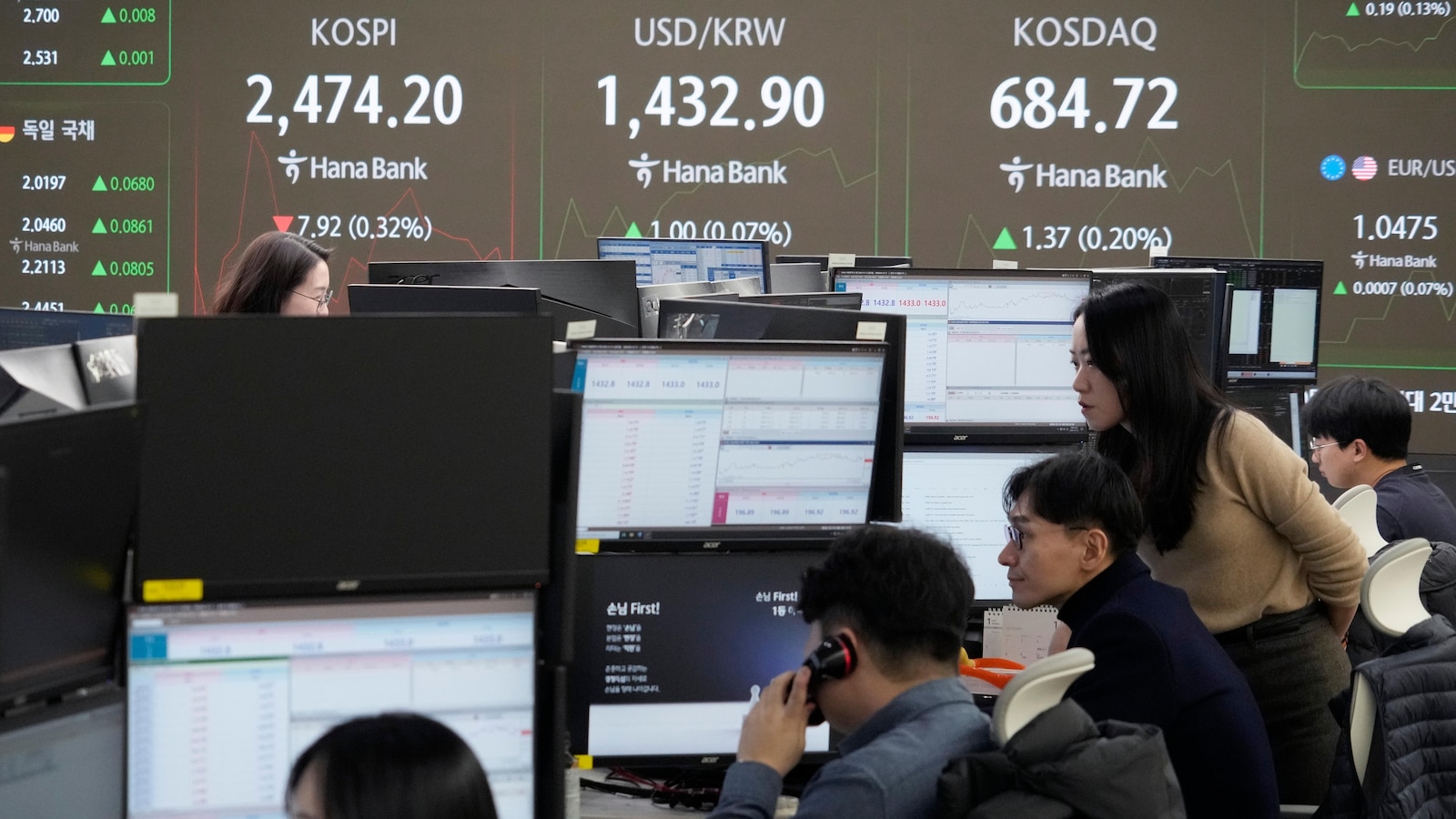Asian stock markets saw a significant downturn today, mirroring the slide observed on Wall Street, as disappointing economic data raised concerns over inflation and economic stability. The latest reports on price trends in the United States have sparked fears that inflationary pressures might persist longer than expected, undermining investor confidence globally. As a result, Asian markets are grappling with the ripple effects of these economic concerns, with analysts predicting heightened volatility in the near term.
Impact of Wall Street’s Decline on Asian Markets
The sharp decline in U.S. equities earlier this week set the tone for a broad pullback in global markets, with the Dow Jones Industrial Average and S&P 500 both experiencing significant losses. The trigger for the sell-off was disappointing price data, which indicated that inflation remains sticky despite efforts by the Federal Reserve to tighten monetary policy. As Asian markets opened on Thursday, the ripple effect was clear, with many indices posting losses by the end of the trading day.
Asian stock markets, including Japan’s Nikkei 225, Hong Kong’s Hang Seng, and South Korea’s Kospi, all experienced steep declines. The Hong Kong Hang Seng index fell by more than 2%, while Japan’s Nikkei 225 lost over 1.5% by mid-day trading. The cause of this downturn is widely attributed to concerns over inflation and its impact on both domestic and global economic growth.
Understanding the Price Data Driving the Market Reaction
The economic data that triggered this global downturn focused primarily on the U.S. Consumer Price Index (CPI), which showed a higher-than-expected increase in core inflation. The CPI, a critical measure of price changes for everyday goods and services, rose by 0.4% month-on-month, indicating persistent inflationary pressures. While the Federal Reserve has raised interest rates to curb inflation, these data suggest that price stability might take longer to achieve, thus raising concerns about the Fed’s future policy moves.
This economic uncertainty in the U.S. has far-reaching effects on international markets. Asian investors are particularly sensitive to U.S. economic performance because of the interconnectedness of the global economy. The decline in U.S. stock prices and the ongoing inflation fears create a volatile environment, prompting investors in Asia to reassess their portfolios and adjust expectations.
Sectoral Performance and Regional Outlook
Within Asia, sectors most sensitive to global economic conditions, such as technology, energy, and finance, were particularly hard hit. Companies reliant on global demand, such as semiconductor manufacturers in South Korea and Japan, faced a tougher environment as investor sentiment soured. Meanwhile, energy stocks, which had previously benefited from rising commodity prices, also saw declines due to fears that inflation could dampen consumer spending and slow global growth.
While the broader market sentiment in Asia has been negative, some regions and sectors are showing signs of resilience. For example, Chinese equities, though still impacted by the broader trend, have received a degree of support due to recent government stimulus measures aimed at boosting domestic demand. This targeted approach contrasts with the more global nature of the U.S. economic issues and suggests that China’s market may decouple from broader global trends in the short term.
Inflation’s Global Impact: A Bigger Picture
As inflation continues to dominate market conversations, its implications extend beyond mere stock market movements. Persistent inflation affects consumer purchasing power, erodes savings, and poses challenges for policymakers worldwide. The Federal Reserve’s interest rate hikes have been a key mechanism for controlling inflation, but higher borrowing costs could suppress economic activity, particularly in sectors such as housing and consumer goods.
In Asia, inflation is a concern in several key economies. For instance, countries like India and Indonesia have faced inflationary pressures driven by rising food and energy prices. Similarly, Japan’s economy, while benefiting from low interest rates, has also witnessed price increases that challenge the stability of its consumer-driven market. These inflationary trends contribute to a global feeling of economic fragility, exacerbating the risk of a slowdown across both developed and developing economies.
Monetary Policies and Their Global Implications
With inflation still a major concern, central banks around the world, particularly the Federal Reserve, the European Central Bank, and the Bank of Japan, face a delicate balancing act. While higher interest rates may help temper inflation, they can also curb economic growth by increasing borrowing costs. For emerging markets, the situation is even more complex, as tighter global liquidity can lead to currency depreciation and increased debt servicing costs, adding further strain to economies already grappling with inflationary pressures.
The divergence in central bank policies is becoming more pronounced. While the U.S. Federal Reserve and the European Central Bank have been more aggressive in tightening monetary policy, Japan has maintained a dovish stance, keeping interest rates at historically low levels. This divergence contributes to the uneven recovery across regions, with some markets benefiting from lower borrowing costs while others struggle with the economic fallout of higher rates.
Investment Sentiment: A Wait-and-See Approach
As the global economic outlook remains uncertain, investment sentiment has shifted towards a more cautious stance. Market participants are adopting a wait-and-see approach, closely monitoring inflation data and central bank decisions. For Asian investors, this means a heightened focus on inflationary pressures and the potential for further rate hikes by the U.S. Federal Reserve, which could impact both equity and currency markets.
- Inflation concerns: Rising prices continue to challenge investor confidence.
- Interest rate policies: Global central banks’ decisions on interest rates are a key factor influencing market movements.
- Sectoral performance: Technology, energy, and finance sectors are most vulnerable to global economic trends.
Despite the current volatility, some analysts remain cautiously optimistic about the long-term outlook. They argue that inflation, though persistent, will eventually moderate as supply chains recover and energy prices stabilize. Furthermore, continued government stimulus measures in major economies, such as China, could provide a floor for market declines and offer opportunities for investors who are willing to take on some risk.
The sharp decline in Asian markets today reflects broader global concerns about inflation and its potential to slow economic growth. As Wall Street’s decline reverberates across Asia, investors must navigate a landscape filled with uncertainty, rising prices, and the potential for more aggressive central bank actions. While short-term volatility is expected, the longer-term outlook will depend heavily on how inflation trends evolve and how central banks respond to these challenges.
For now, Asian markets remain under pressure, but there are signs that the situation may stabilize as inflationary pressures ease and global economic growth stabilizes. Investors are advised to stay informed and remain flexible in their strategies, as the situation continues to unfold.
For more insights into how global market trends are shaping the Asian economy, visit our market analysis page.
For a deeper dive into the latest economic data and inflation trends, read more on Reuters.
See more CNBC Network



